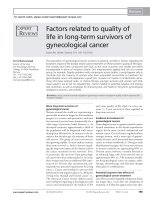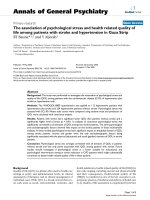Factors related to postoperative symptoms among patients undergoing abdominal surgery
Bạn đang xem bản rút gọn của tài liệu. Xem và tải ngay bản đầy đủ của tài liệu tại đây (71.37 KB, 5 trang )
Journal of military pharmaco-medicine no3-2018
FACTORS RELATED TO POSTOPERATIVE SYMPTOMS
AMONG PATIENTS UNDERGOING ABDOMINAL SURGERY
Nguyen Hoang Long*
SUMMARY
Objectives: This study aimed to identify postoperative symptoms and related factors during
the first three days after abdominal surgery. Subjects and methods: Data was collected from
147 patients undergoing elective surgery evaluating by Hospital Anxiety and Depression Scale,
Multi-Dimensional Social Support Scale and the Memorial Symptom Assessment Scale in
pre-operation and three consecutive days of post-operation. Results: The results identified
seven symptoms occurred, including pain, tiredness, sleeplessness, abdominal distension,
urinary retention, anxiety, and dizziness. The overall mean score of symptoms was high on the
first day then was decreased on the two following days. On the first day, symptoms were
correlated to age (r = -0.25, p < 0.01), length of operative procedure (r = 0.48, p < 0.01), incision
length (r = 0.27, p < 0.01), and preoperative anxiety (r = 0.16, p < 0.05). On the second day,
only length of operation time significantly related to symptoms (r = 0.48, p < 0.01). On the third
day, there were age, length of operative procedure, and incision length associated with
symptoms (r = -0.18, 0.30 and 0.31, respectively). Conclusion: Post-operative symptoms need
to be managed properly. Nurses should prioritize their symptoms management program to
elderly patients as well as ones with long incision and long operative time.
* Keywords: Abdominal surgery; Postoperative symptoms; Unpleasant symptoms; Related factors.
INTRODUCTION
Worldwide studies have repeatedly
reported a high incidence of unpleasant
symptoms following surgery [1]. From the
same point of view, researchers interested
in abdominal surgery demonstrated that
symptoms following this type of operation
were very problematic. For instance, 51%
to 95% of patients reported suffering from
at least moderate pain; 92% complained
about the increase in fatigue after
operation; 20% demonstrated a high level
of postoperative anxiety [2]. Some even
asserted that abdominal surgery was the
most painful of all operative procedures
[3]. Paradoxically, since it involves in
treatments for many of the organs,
abdominal surgery might be the most
frequent operative procedure.
It is evident that symptoms after operation
prolong recovery, increase complication,
lower patient satisfaction with health care
service, and diminish quality of life [1, 4].
In theory, symptoms are determined by
various variables, classified as physiological,
psychological, and situational factors [5].
* Vinmec Hospital
Corresponding author: Nguyen Hoang Long ()
Date received: 30/12/2017
Date accepted: 28/02/2018
128
Journal of military pharmaco-medicine n03-2018
Nevertheless, there is no general agreement
about the relationships among variables
such as age, gender, preoperative anxiety,
the severity of operations, etc., and
postoperative symptoms across studies
[2, 3, 4, 6]. The disagreements in findings
among previous studies reflected the
complexity in determining which factors
and how those variables related to an
individual’s symptom experience.
This research aimed to identify the
prevalence of symptoms occurring in
72 hours postoperatively and to examine
relationships among factors, including age,
gender, social support, length of operative
procedure, incision size, pre-operative
anxiety and postoperative symptoms among
those who undergo abdominal surgery.
* Conceptual framework:
The theory of unpleasant symptom [5]
provided a theoretical reasoning for the
present study. Lenz and colleagues assumed
that every symptom manifests itself in four
dimensions: intensity, duration, quality,
and distress. Symptoms may either occur
alone or simultaneously, and a certain
symptom can precede the occurrence
of one other. Symptom experience
consequently,. results in the alteration in
performance of an individual. Adversely,
symptoms are determined by a mixture of
factors impacted on how an individual
perceives and experiences a symptom.
SUBJECTS AND METHODS
A correlational descriptive design was
used. 147 patients undergoing major
elective abdominal surgery were recruited
from three teaching hospitals located in
Hanoi, Vietnam. Data were collected by
structured interview four times. Firstly,
on the day before surgery, pre-operative
anxiety was evaluated by the Hospital
Anxiety and Depression Scale (HADS-A)
[7]. Then, postoperative symptoms were
measured for three days by the modified
Memorial Symptom Assessment Scale
(MSAS) [8]. On the third day after surgery,
social support was examined by the Multidimensional Support Scale (MDSS) [9].
The internal consistency of the instruments
was calculated. The Cronbach’s alpha for
the HADS-A, MSAS, and MDSS were
0.89, 0.79, and 0.74, respectively.
RESULTS AND DISCUSSION
Table 1: Symptom occurrences, and symptom scores during three days after surgery
(n = 147).
st
1 day
Freq. (%)
Total scores (0 - 84)
x
2
(SD)
nd
Freq. (%)
40.47 (5.16)
rd
day
3 day
x
(SD)
Freq. (%)
26.33 (5.03)
x
(SD)
19.16 (3.63)
Pain
147 (100%)
9.14 (0.79)
147 (100%)
7.15 (1.30)
147 (100%)
4.55 (0.82)
Tiredness
147 (100%)
8.80 (1.27)
147 (100%)
6.61 (1.19)
147 (100%)
4.93 (1.19)
Sleeplessness
147 (100%)
9.23 (1.57)
147 (100%)
6.22 (1.16)
147 (100%)
4.65 (1.03)
129
Journal of military pharmaco-medicine no3-2018
Abdominal distension 147 (100%)
5.88 (2.19)
47 (32%)
0.8 (1.23)
0 (0%)
0
Urinary retention
132 (89.8%)
5.60 (2.61)
44 (29.9%)
0.85 (1.43)
0 (0%)
0
Anxiety
79 (53.7%)
1.78 (1.83)
111 (75.5%)
2.86 (2.07)
63 (42.2%)
1.59 (2.09)
2 (1.4%)
0.03 (0.29)
104 (70.7%)
1.84 (1.31)
128 (87.1%)
3.45 (1.87)
Dizziness
The findings identified seven symptoms
existed during 72 hours after surgery,
including pain, tiredness, sleeplessness,
abdominal distention, dizziness, urinary
retention, and anxiety. Notably, while pain,
tiredness, and sleeplessness presented in
all patients along three days, abdominal
distention and urinary retention occurred
in only the first two days. The overall
mean score of symptoms on the first day,
the second day, and the third day were
40.47 (S.D = 5.16), 26.33 (S.D = 5.03),
and 19.16 (S.D = 3.63), consecutively.
Most of the symptoms reduced gradually.
However, dizziness constantly increased
during three days. Anxiety increased in
the second day, but then decreased in the
third day. During three days, pain remained
as one the most severe symptoms. This
finding reinforced the problematic presence
of pain reflecting that postoperative pain
management was still suboptimal [3, 6].
The findings revealed significant relationships
among pain, tiredness, and sleeplessness
along three days (correlation coefficients
ranged from .19 to .64). Cluster analysis
suggested that these symptoms could be
grouped as the cluster occurred during
three postoperative days. Lenz et al (1997)
assumed that the accumulate effect of
multiple symptoms is not, and more
problematic than a “simple” combination
of those individual discomforts [5]. Thus,
the coexistence of pain, tiredness and
130
sleeplessness highlights a need for a proper
symptom management. It also recommends
that these symptoms should be included
together in all nursing assessment, planning,
and implementing therapeutics.
Although previous studies demonstrated
that dizziness generally reduced after
increasing in the second day [1], this
study found it continuously increased during
three days. Possibly, this difference resulted
from the delay in early ambulation of the
current sample. Despite patients were
recommended to ambulate since the
second day after operation, they tended
to start later because of pain, tiredness
and the worry about incision stability.
Therefore, both the number of persons
involving in and the volume of ambulation
activities increased from day to day.
Consequently, because of the mobilization
patients felt dizzier. This study pointed out
that anxiety increased on day two and
then decreased on day three after operation.
Probably, on the second day, symptoms
had generally decreased but still remained
high severity. Thus, patients felt more
anxious. However, on the third day, when
patients got better and symptoms were
significantly relieved, anxiety decreased.
For the independent variables, it was
shown that 53.1% of the sample was males
and the mean of age was 55.2 years
(SD = 15.06). The average duration of
Journal of military pharmaco-medicine n03-2018
operations was 153.3 minutes (SD = 50.10);
and the mean length of incision was
15.7 cm. Additionally, patients reported a mild
level of preoperative anxiety (mean = 6.9,
SD = 3.4). The mean of social support
score was 13.8 (SD = 3.2).
Table 2: Pearson correlation coefficients
among independent variables and total
symptom scores in three days (n = 147).
Total symptom scores
The
first
day
The
second
day
The
third
day
-.25(**)
-.08
-.18(*)
.02
-.01
.10
.48(**)
.48(**)
.30(**)
Incision length
.27(**)
.10
.31(**)
Pre-operative anxiety
.16(*)
-.05
-.01
Social support (total)
-.01
-.001
.05
Age
Gender
Length of
procedure
operative
(** Correlation is significant at the 0.01
level (1-tailed); * Correlation is significant
at the 0.05 level (1-tailed))
There were small to moderate positive
associations among duration of operative
procedure, incision length and postoperative
symptoms. In some degree, these two
factors could be used as the representative
of the operation’s severity. When the
operation is more severe, consequently,
symptoms occurred more problematically.
Similar to incision length and operation
length, anxiety prior to surgery was found
to be positively associated with postoperative
symptoms on the first day (r = 16, p < .05).
This stressed that psychological factors
should not be neglected in symptom
management. Furthermore, it also suggested
that patients might benefit from nursing
intervention alleviating pre-operative anxiety
with regard to reduce postoperative symptoms.
Age is negatively related to postoperative
symptoms. The finding was in agreement
with another study by Kalkman et al
(2003) [3]. However, this result did not
imply that nurses can under-consider
symptoms among elderly individuals.
In fact, it highlights that nurses should
assess the old patients more carefully
since the presence of symptoms in this
population is easily to be overlooked.
While previous studies asserted significant
relationships among gender, social support
and postoperative symptoms [3], this study
had failed to confirm these associations.
It reflected a complexity in determining
the roles of factors related to symptom
experiences. In addition, it was
recommended that the effectiveness of
support from others should be improved
to cushion patients’ postoperative symptoms.
CONCLUSION AND
RECOMMENDATION
This study figured out the problematic
presence of symptoms occurred the early
time after abdominal surgery. The roles of
severity of operation, age and preoperative
anxiety in relation with post-surgery
symptoms had also been proven. These
findings pointed to the need of a proper
symptom management for post-surgery
population. Further investigations on
symptom experience and symptom
management in this population are also
recommended with regard to enhancing
the treatment outcomes.
131
Journal of military pharmaco-medicine no3-2018
RERERENCES
1. Rosén H, L Clabo, L. Matensson.
Symptoms following day surgery: A review of
the literature. Journal of Advanced Perioperative
Care. 2009, 4 (1), pp.7-18.
2. Carr E et al. Patterns and frequency of
anxiety in women undergoing gynaecological
surgery. Journal of Clinical Nursing. 2006, 15,
pp.341-352.
3. Kalkman C et al. Preoperative prediction
of severe postoperative pain. Pain. 2003, 105,
pp.415-423.
4. Mace L. An audit of postoperative nausea
and vomiting, following cardiac surgery: Scope
of the problem. Nursing in Critical Care. 2003,
8 (5), pp.187-196.
5. Lenz E et al. The middle range theory of
unpleasant symptoms: An update. Advances
in Nursing Science. 1997, 19 (3), pp.14-27.
132
6. Carroll K et al. Pain assessment and
management in critically ill postoperative
and trauma patients: A
multisite study.
American Journal of Critical Care. 1999, 8 (2),
pp.105-117.
7. Zigmond A, Snaith R. The Hospital
Anxiety and Depression Scale. Acta Psychiatr
Scand. 1983, 67, pp.361-370.
8. Portenoy R et al. The Memorial
Symptom Assessment Scale: An instrument
for the evaluation of symptom prevalence,
characteristics and distress. European Journal
of Cancer. 1994, 30 (90), pp.1326-1336.
9. Winefield H, Winefield A, Tiggemann M.
Social support and psychological well-being in
young adults: The Multi-Dimensional Support
Scale. Journal of Personality Assessment.
1992, 58 (1), pp.198-210.









